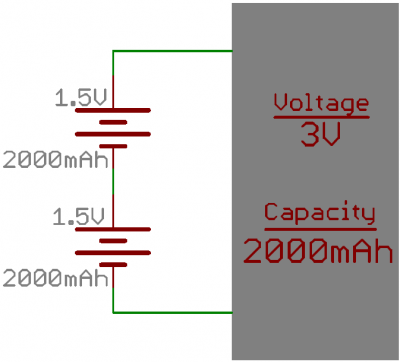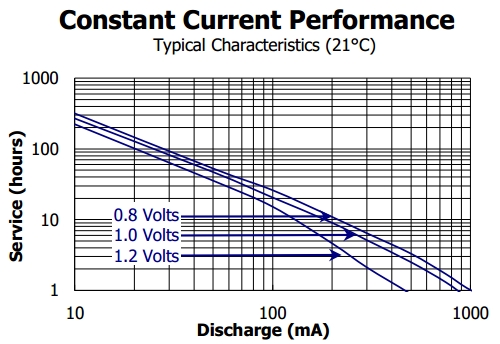How to Power a Project
Remote/Mobile Power
Which Battery Should I Choose?
When you're powering a remote circuit, the same issues of finding a battery that delivers the proper voltage and current still apply. Battery life, or capacity, is a measure of total charge the battery contains. The capacity of a battery is usually rated in ampere-hours (Ah) or milliampere-hours (mAh), and it tells you how many amps a fully charged battery can supply over a period of one hour. For example, a 2000mAh battery can supply up to 2A (2000mA) for one hour.
Battery size, shape, and weight is also something to consider when making your project mobile, especially if it's going to be on something that flies like a small quad-copter. You can get a rough idea of the variety by visiting this Wikipedia list. Learn more about battery types in our battery technology tutorial.
Battery Technologies
Batteries in Series and Parallel
You can add batteries in series or parallel to produce the desired voltage and current needed for your project. When two or more batteries are placed in series, the voltages of the batteries are added together. For example, lead-acid car batteries are actually made out of six single-cell lead acid batteries tied together in series; the six 2.1V cells add up to produce 12.6V. When tying two batteries in series, it's recommended that they be of the same chemistry. Also, be wary of charging batteries in series as many chargers are limited to single-cell charging.
When you connect two or more batteries in parallel, the capacities add. For example, four AA batteries connected in parallel will still produce 1.5V, however the capacity of the batteries will be quadrupled.
How Much Battery Capacity Do I Need For My Project?
This question is easier to answer once you have determined the amount of current that your circuit normally draws. In the following example, we will use estimation. However, it is encouraged that you measure current draw of your circuit using a Digital Multimeter to get accurate results.
As an example, let’s start with a circuit, estimate its current output, then select a battery and calculate how long it the circuit will run on battery power. Let’s choose a ATmega 328 microcontroller to be our brains for the circuit. It draws about 20mA under normal conditions. Let’s now connect three red LED’s and the standard 330 ohm current limiting resistors to digital I/O pins of the microcontroller. In that configuration, each LED added makes the circuit draw about 10mA more current. Now let’s connect two Micro Metal motors to the microcontroller as well. Each one of these uses approximately 25mA when turned on. Our total possible current draw is now:
Let’s choose a standard alkaline AA battery for this because it has more than enough current capability (up to 1A), has a decent battery capacity (usually in the range of 1.5 Ah to 2.5Ah), and is very common. We'll assume the average is 2Ah for this example. The downside to using a AA is it only has a 1.5V output, and, since the rest of our components will run on 5V, we need to step up the voltage. We can use this 5V step-up breakout to get the voltage we need, or we can use three AA batteries in series to get us close to the voltage we need. Three AA’s in series gives us a voltage of 4.5 V (3 times 1.5V). You could also add another battery for a total of 6V and regulate the voltage down to what your circuit requires.
To calculate how long a circuit will last on battery power, we use the following equation:
For a circuit powered by 3 AA's in parallel that's connected to a circuit with a constant 100mA current draw, this translates to:
We would ideally get 60 hours of battery life out of these three alkaline AA’s in this parallel configuration. However, it’s good practice to ‘derate’ batteries, which means to assume you’re going to get less than ideal battery life. Let’s conservatively say that we’ll get 75% of the ideal battery life, and therefore about 45 hours of battery life for our project.
Battery life can also vary based on the actual current draw amount. Here's a graph from an Energizer AA battery showing its expected battery life based on constant current draw.
This is just one of the numerous configurations you could use to power your project remotely.




